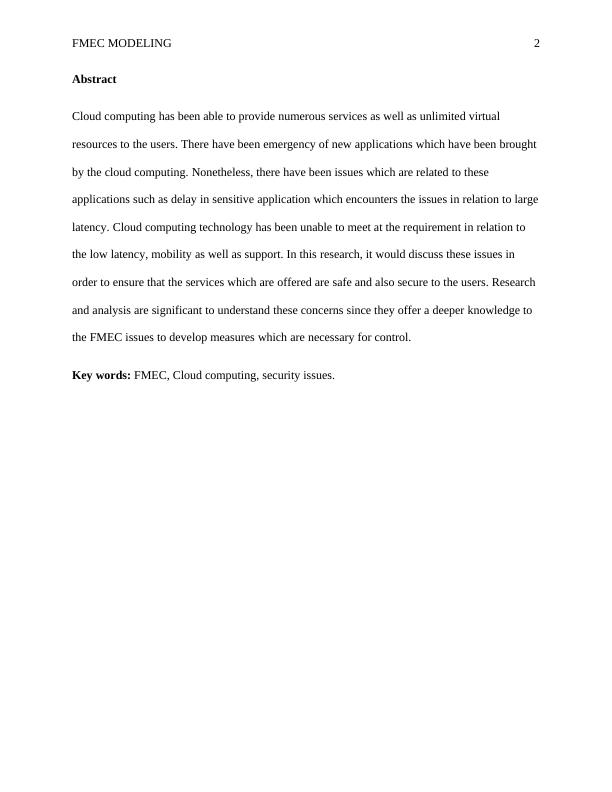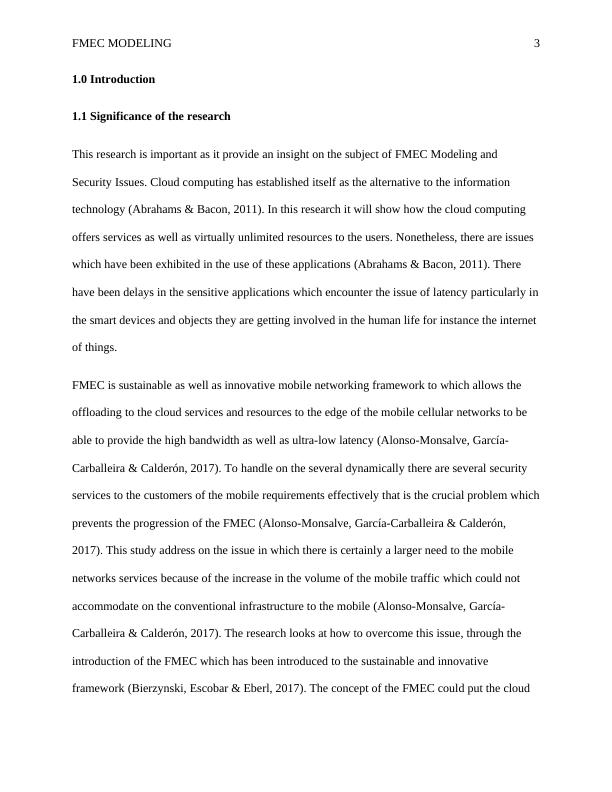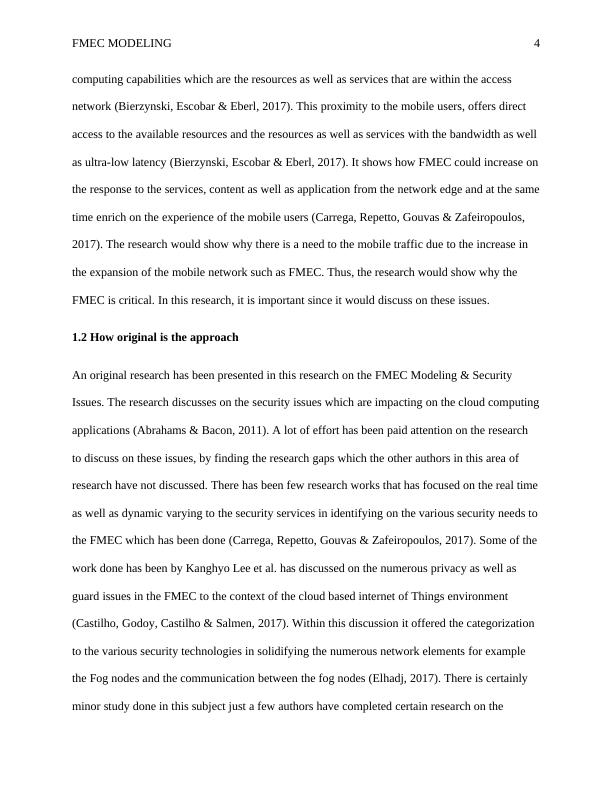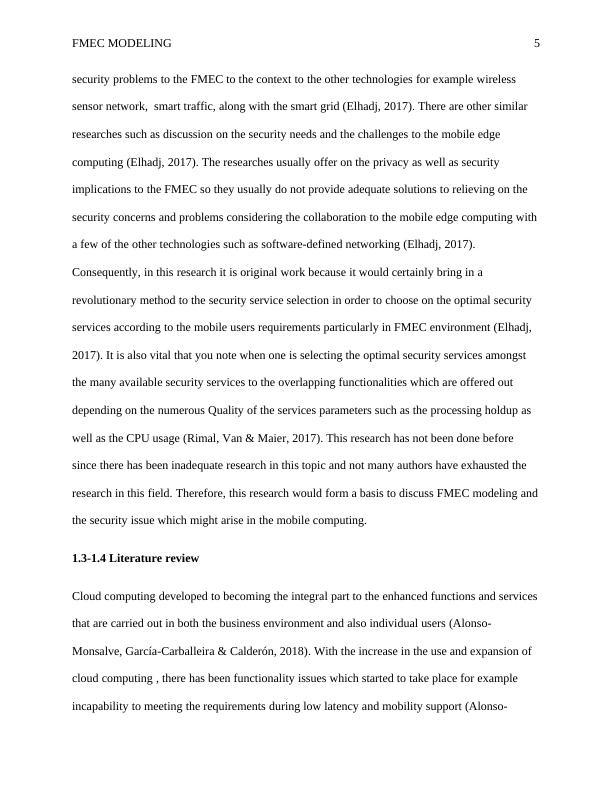Unlimited Virtual Resources PDF
21 Pages6860 Words37 Views
Added on 2021-04-17
Unlimited Virtual Resources PDF
Added on 2021-04-17
ShareRelated Documents
Running head: FMEC MODELING 1
FMEC Modeling & Security Issues
Name:
Institution Affiliation:
FMEC Modeling & Security Issues
Name:
Institution Affiliation:

FMEC MODELING 2
Abstract
Cloud computing has been able to provide numerous services as well as unlimited virtual
resources to the users. There have been emergency of new applications which have been brought
by the cloud computing. Nonetheless, there have been issues which are related to these
applications such as delay in sensitive application which encounters the issues in relation to large
latency. Cloud computing technology has been unable to meet at the requirement in relation to
the low latency, mobility as well as support. In this research, it would discuss these issues in
order to ensure that the services which are offered are safe and also secure to the users. Research
and analysis are significant to understand these concerns since they offer a deeper knowledge to
the FMEC issues to develop measures which are necessary for control.
Key words: FMEC, Cloud computing, security issues.
Abstract
Cloud computing has been able to provide numerous services as well as unlimited virtual
resources to the users. There have been emergency of new applications which have been brought
by the cloud computing. Nonetheless, there have been issues which are related to these
applications such as delay in sensitive application which encounters the issues in relation to large
latency. Cloud computing technology has been unable to meet at the requirement in relation to
the low latency, mobility as well as support. In this research, it would discuss these issues in
order to ensure that the services which are offered are safe and also secure to the users. Research
and analysis are significant to understand these concerns since they offer a deeper knowledge to
the FMEC issues to develop measures which are necessary for control.
Key words: FMEC, Cloud computing, security issues.

FMEC MODELING 3
1.0 Introduction
1.1 Significance of the research
This research is important as it provide an insight on the subject of FMEC Modeling and
Security Issues. Cloud computing has established itself as the alternative to the information
technology (Abrahams & Bacon, 2011). In this research it will show how the cloud computing
offers services as well as virtually unlimited resources to the users. Nonetheless, there are issues
which have been exhibited in the use of these applications (Abrahams & Bacon, 2011). There
have been delays in the sensitive applications which encounter the issue of latency particularly in
the smart devices and objects they are getting involved in the human life for instance the internet
of things.
FMEC is sustainable as well as innovative mobile networking framework to which allows the
offloading to the cloud services and resources to the edge of the mobile cellular networks to be
able to provide the high bandwidth as well as ultra-low latency (Alonso-Monsalve, García-
Carballeira & Calderón, 2017). To handle on the several dynamically there are several security
services to the customers of the mobile requirements effectively that is the crucial problem which
prevents the progression of the FMEC (Alonso-Monsalve, García-Carballeira & Calderón,
2017). This study address on the issue in which there is certainly a larger need to the mobile
networks services because of the increase in the volume of the mobile traffic which could not
accommodate on the conventional infrastructure to the mobile (Alonso-Monsalve, García-
Carballeira & Calderón, 2017). The research looks at how to overcome this issue, through the
introduction of the FMEC which has been introduced to the sustainable and innovative
framework (Bierzynski, Escobar & Eberl, 2017). The concept of the FMEC could put the cloud
1.0 Introduction
1.1 Significance of the research
This research is important as it provide an insight on the subject of FMEC Modeling and
Security Issues. Cloud computing has established itself as the alternative to the information
technology (Abrahams & Bacon, 2011). In this research it will show how the cloud computing
offers services as well as virtually unlimited resources to the users. Nonetheless, there are issues
which have been exhibited in the use of these applications (Abrahams & Bacon, 2011). There
have been delays in the sensitive applications which encounter the issue of latency particularly in
the smart devices and objects they are getting involved in the human life for instance the internet
of things.
FMEC is sustainable as well as innovative mobile networking framework to which allows the
offloading to the cloud services and resources to the edge of the mobile cellular networks to be
able to provide the high bandwidth as well as ultra-low latency (Alonso-Monsalve, García-
Carballeira & Calderón, 2017). To handle on the several dynamically there are several security
services to the customers of the mobile requirements effectively that is the crucial problem which
prevents the progression of the FMEC (Alonso-Monsalve, García-Carballeira & Calderón,
2017). This study address on the issue in which there is certainly a larger need to the mobile
networks services because of the increase in the volume of the mobile traffic which could not
accommodate on the conventional infrastructure to the mobile (Alonso-Monsalve, García-
Carballeira & Calderón, 2017). The research looks at how to overcome this issue, through the
introduction of the FMEC which has been introduced to the sustainable and innovative
framework (Bierzynski, Escobar & Eberl, 2017). The concept of the FMEC could put the cloud

FMEC MODELING 4
computing capabilities which are the resources as well as services that are within the access
network (Bierzynski, Escobar & Eberl, 2017). This proximity to the mobile users, offers direct
access to the available resources and the resources as well as services with the bandwidth as well
as ultra-low latency (Bierzynski, Escobar & Eberl, 2017). It shows how FMEC could increase on
the response to the services, content as well as application from the network edge and at the same
time enrich on the experience of the mobile users (Carrega, Repetto, Gouvas & Zafeiropoulos,
2017). The research would show why there is a need to the mobile traffic due to the increase in
the expansion of the mobile network such as FMEC. Thus, the research would show why the
FMEC is critical. In this research, it is important since it would discuss on these issues.
1.2 How original is the approach
An original research has been presented in this research on the FMEC Modeling & Security
Issues. The research discusses on the security issues which are impacting on the cloud computing
applications (Abrahams & Bacon, 2011). A lot of effort has been paid attention on the research
to discuss on these issues, by finding the research gaps which the other authors in this area of
research have not discussed. There has been few research works that has focused on the real time
as well as dynamic varying to the security services in identifying on the various security needs to
the FMEC which has been done (Carrega, Repetto, Gouvas & Zafeiropoulos, 2017). Some of the
work done has been by Kanghyo Lee et al. has discussed on the numerous privacy as well as
guard issues in the FMEC to the context of the cloud based internet of Things environment
(Castilho, Godoy, Castilho & Salmen, 2017). Within this discussion it offered the categorization
to the various security technologies in solidifying the numerous network elements for example
the Fog nodes and the communication between the fog nodes (Elhadj, 2017). There is certainly
minor study done in this subject just a few authors have completed certain research on the
computing capabilities which are the resources as well as services that are within the access
network (Bierzynski, Escobar & Eberl, 2017). This proximity to the mobile users, offers direct
access to the available resources and the resources as well as services with the bandwidth as well
as ultra-low latency (Bierzynski, Escobar & Eberl, 2017). It shows how FMEC could increase on
the response to the services, content as well as application from the network edge and at the same
time enrich on the experience of the mobile users (Carrega, Repetto, Gouvas & Zafeiropoulos,
2017). The research would show why there is a need to the mobile traffic due to the increase in
the expansion of the mobile network such as FMEC. Thus, the research would show why the
FMEC is critical. In this research, it is important since it would discuss on these issues.
1.2 How original is the approach
An original research has been presented in this research on the FMEC Modeling & Security
Issues. The research discusses on the security issues which are impacting on the cloud computing
applications (Abrahams & Bacon, 2011). A lot of effort has been paid attention on the research
to discuss on these issues, by finding the research gaps which the other authors in this area of
research have not discussed. There has been few research works that has focused on the real time
as well as dynamic varying to the security services in identifying on the various security needs to
the FMEC which has been done (Carrega, Repetto, Gouvas & Zafeiropoulos, 2017). Some of the
work done has been by Kanghyo Lee et al. has discussed on the numerous privacy as well as
guard issues in the FMEC to the context of the cloud based internet of Things environment
(Castilho, Godoy, Castilho & Salmen, 2017). Within this discussion it offered the categorization
to the various security technologies in solidifying the numerous network elements for example
the Fog nodes and the communication between the fog nodes (Elhadj, 2017). There is certainly
minor study done in this subject just a few authors have completed certain research on the

FMEC MODELING 5
security problems to the FMEC to the context to the other technologies for example wireless
sensor network, smart traffic, along with the smart grid (Elhadj, 2017). There are other similar
researches such as discussion on the security needs and the challenges to the mobile edge
computing (Elhadj, 2017). The researches usually offer on the privacy as well as security
implications to the FMEC so they usually do not provide adequate solutions to relieving on the
security concerns and problems considering the collaboration to the mobile edge computing with
a few of the other technologies such as software-defined networking (Elhadj, 2017).
Consequently, in this research it is original work because it would certainly bring in a
revolutionary method to the security service selection in order to choose on the optimal security
services according to the mobile users requirements particularly in FMEC environment (Elhadj,
2017). It is also vital that you note when one is selecting the optimal security services amongst
the many available security services to the overlapping functionalities which are offered out
depending on the numerous Quality of the services parameters such as the processing holdup as
well as the CPU usage (Rimal, Van & Maier, 2017). This research has not been done before
since there has been inadequate research in this topic and not many authors have exhausted the
research in this field. Therefore, this research would form a basis to discuss FMEC modeling and
the security issue which might arise in the mobile computing.
1.3-1.4 Literature review
Cloud computing developed to becoming the integral part to the enhanced functions and services
that are carried out in both the business environment and also individual users (Alonso-
Monsalve, García-Carballeira & Calderón, 2018). With the increase in the use and expansion of
cloud computing , there has been functionality issues which started to take place for example
incapability to meeting the requirements during low latency and mobility support (Alonso-
security problems to the FMEC to the context to the other technologies for example wireless
sensor network, smart traffic, along with the smart grid (Elhadj, 2017). There are other similar
researches such as discussion on the security needs and the challenges to the mobile edge
computing (Elhadj, 2017). The researches usually offer on the privacy as well as security
implications to the FMEC so they usually do not provide adequate solutions to relieving on the
security concerns and problems considering the collaboration to the mobile edge computing with
a few of the other technologies such as software-defined networking (Elhadj, 2017).
Consequently, in this research it is original work because it would certainly bring in a
revolutionary method to the security service selection in order to choose on the optimal security
services according to the mobile users requirements particularly in FMEC environment (Elhadj,
2017). It is also vital that you note when one is selecting the optimal security services amongst
the many available security services to the overlapping functionalities which are offered out
depending on the numerous Quality of the services parameters such as the processing holdup as
well as the CPU usage (Rimal, Van & Maier, 2017). This research has not been done before
since there has been inadequate research in this topic and not many authors have exhausted the
research in this field. Therefore, this research would form a basis to discuss FMEC modeling and
the security issue which might arise in the mobile computing.
1.3-1.4 Literature review
Cloud computing developed to becoming the integral part to the enhanced functions and services
that are carried out in both the business environment and also individual users (Alonso-
Monsalve, García-Carballeira & Calderón, 2018). With the increase in the use and expansion of
cloud computing , there has been functionality issues which started to take place for example
incapability to meeting the requirements during low latency and mobility support (Alonso-

FMEC MODELING 6
Monsalve, García-Carballeira & Calderón, 2018) . To have the ability to handle these types of
concerns specialized disciplines this really is regarded as Fog and Mobile Edge Computing-
FMEC which has been developed. There have been numerous researches which have been
recently done in the section of FMEC which has offered the cloud users to have a close link up
with the services. Nonetheless, there have been types of modeling and security issues which are
present in FMEC services. It is important to have some ideas in regards to these issues to ensure
that the services which are offered are safe and also secure to the users (Alonso-Monsalve,
García-Carballeira & Calderón, 2018).
Cloud computing continues to be long thought to be the cornerstones to the future internet
systems , which has been due to the ability to accommodate the computational as well as storage
case power to the mobile and computing devices (Rimal, Van & Maier, 2017). The major
disadvantage that has recently been associated to the cloud computing generally originate from
its centralized nature, that avoids it from providing reasonable times , mobility support or
perhaps being aware to the context of the users (Rimal, Van & Maier, 2017). This normally
continues to be encouraged by the emergence to the Edge Computing paradigms , similar to the
cloud particularly in the sense that provide the computation as well as storage capabilities to be
placed to the end users, particularly to in which the data has being generated (Rimal, Van &
Maier, 2017). Nonetheless, this method does not necessary imply that obtaining rid to the cloud
but instead having multi tier architecture to in which some of the operations might be carried out
in a manner that is fashionable through handling them to the nearby edge data centers instead
relying upon the distant cloud server which are at the backbone (Rimal, Van & Maier, 2017).
The fog computing is certainly one example to the Edge Computing ecosystem (Rimal, Van &
Maier, 2017). The fog devices usually coexist with the cloud servers and the end users devices
Monsalve, García-Carballeira & Calderón, 2018) . To have the ability to handle these types of
concerns specialized disciplines this really is regarded as Fog and Mobile Edge Computing-
FMEC which has been developed. There have been numerous researches which have been
recently done in the section of FMEC which has offered the cloud users to have a close link up
with the services. Nonetheless, there have been types of modeling and security issues which are
present in FMEC services. It is important to have some ideas in regards to these issues to ensure
that the services which are offered are safe and also secure to the users (Alonso-Monsalve,
García-Carballeira & Calderón, 2018).
Cloud computing continues to be long thought to be the cornerstones to the future internet
systems , which has been due to the ability to accommodate the computational as well as storage
case power to the mobile and computing devices (Rimal, Van & Maier, 2017). The major
disadvantage that has recently been associated to the cloud computing generally originate from
its centralized nature, that avoids it from providing reasonable times , mobility support or
perhaps being aware to the context of the users (Rimal, Van & Maier, 2017). This normally
continues to be encouraged by the emergence to the Edge Computing paradigms , similar to the
cloud particularly in the sense that provide the computation as well as storage capabilities to be
placed to the end users, particularly to in which the data has being generated (Rimal, Van &
Maier, 2017). Nonetheless, this method does not necessary imply that obtaining rid to the cloud
but instead having multi tier architecture to in which some of the operations might be carried out
in a manner that is fashionable through handling them to the nearby edge data centers instead
relying upon the distant cloud server which are at the backbone (Rimal, Van & Maier, 2017).
The fog computing is certainly one example to the Edge Computing ecosystem (Rimal, Van &
Maier, 2017). The fog devices usually coexist with the cloud servers and the end users devices

End of preview
Want to access all the pages? Upload your documents or become a member.
Related Documents
A Study on Cloud Computing Serviceslg...
|6
|1689
|202
FMEC Modeling and Security Issues - Deskliblg...
|8
|426
|94
Emerging Technologies and Innovations Assignmentlg...
|12
|3655
|68
Cloud Computing: Overview, Strengths, Weaknesses, and Challengeslg...
|8
|2201
|438
Data Security in Cloud Computinglg...
|7
|1953
|270
Internet of Things: Security and Privacy Issues in Cloud and Fog Domainlg...
|8
|1892
|23
